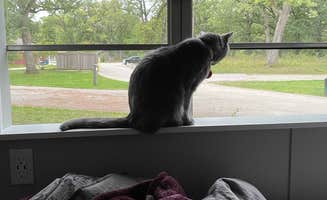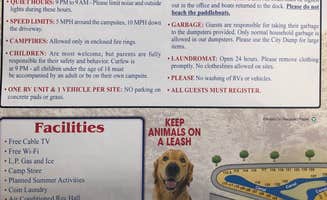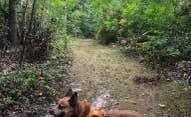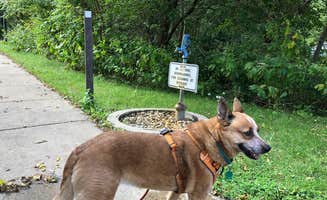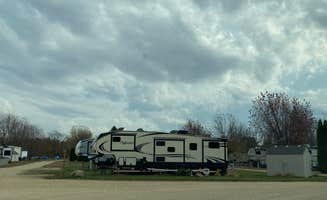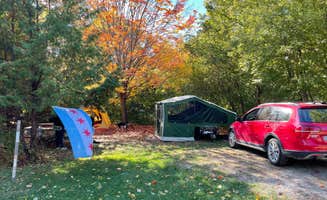Carpentersville camping sites benefit from the area's unique glacial landscape, with rolling hills and kettle ponds formed 12,000 years ago during the Wisconsin glaciation. Average summer temperatures range between 70-85°F, with fall camping season typically extending through late October when nighttime temperatures drop to the 40s. Most campgrounds sit at elevations between 750-850 feet above sea level.
What to do
**Wildlife viewing: Miles of diverse trails at Thomas Woods Campground showcase native Illinois species. "We hiked the trail and saw a mother deer feeding her 2 babies. Hard to believe that there is hiking trails like those in such a densely populated area just outside Elgin," notes camper Tricia E. Morning and evening hours offer the best wildlife spotting opportunities.
**Fishing opportunities: Multiple stocked lakes within 20 minutes of Carpentersville provide shore fishing without a boat. At Honeysuckle Hollow, "There is a water way fee per kayak or canoe per year but it is well worth it," shares Scott B. Chain O' Lakes State Park contains 488 acres of water across 15 interconnected lakes.
**Trail exploration: Interconnected multi-use paths allow hiking and biking through varied terrain. At Rock Cut State Park, a camper notes, "There are plenty of scenic photo opportunities especially during the fall season." The park features nearly 40 miles of trails, including dedicated equestrian paths and an equestrian campground.
What campers like
**Clean facilities: Campers consistently praise the maintenance of bathrooms and showers in the area. At Camp Reinberg, "Bathrooms and showers decent. Would definitely stay here again if outside of Chicago area!" reports Nomad Nurse Z. Most campgrounds clean facilities multiple times daily during peak season.
**Friendly staff: Ranger patrols and attentive hosts enhance the camping experience. "Great campsite with the best staff ever! The sites are clean and very well maintained. We loved the staff patrolling the grounds," writes David W. about Paul Wolff Campground. Patrol schedules typically include hourly rounds between 7am-10pm.
**Spacious sites: Many campgrounds offer generous camping spots with natural buffers. At Blackwell Family Campground, "Most are wooded on each side for privacy. There is a nice shower facility. The grounds include a lake for boating, hiking trails, and bike paths," shares Jen E. Site measurements typically range from 25-40 feet wide.
What you should know
**Reservation requirements: Most campgrounds fill quickly during summer weekends. "That it is a very clean camp ground. There are a lot of activity for kids on the weekends. Plus they have a quiet time at night. So people and kids can go to bed without a bunch of noise," notes Marty S. about Chicago Northwest KOA. Reservations open 6 months in advance at most locations.
**Tick awareness: Wooded areas require preventative measures. "SO many ticks. With a baby crawling that needed to be set free, we were constantly doing checks," warns one camper at Honeysuckle Hollow. Regular clothing checks and repellent application are essential during warmer months.
**Limited water access: Some campgrounds lack water hookups at individual sites. At Thomas Woods, "Hand pumps for water and well-kept pit toilets. Hiking galore!" reports Marisa A. Campers should arrive with filled water tanks or containers, as spigots can be spaced far apart.
Tips for camping with families
**Playground proximity: Choose sites near recreational facilities for easier supervision. "Lots of fun activities for the kids to do. The attendant was very nice and informative," shares Cj C. about Chicago Northwest KOA. Most family-oriented campgrounds have playgrounds within 5-minute walks of camping loops.
**Beginner-friendly trails: Several preserves feature novice-appropriate paths for younger hikers. "We like to hike and this site had great (kid and beginner adult level) trails. We were in town for the Sgt Tommys fishing day and lived that event as well," notes Nicole R. about Blackwell Forest Preserve. Trail maps typically mark skill levels at trailheads.
**Ranger programs: Educational activities often run weekends at larger preserves. At Lehmans Lakeside RV Resort, "The park was still kept up very nicely and this time I was here long enough to be able to see how. The grass is mowed every week. There is patroling at all hours for security," observes Ron R. Programs typically run 1-2 hours on Saturday mornings.
Tips from RVers
**Electric reliability: Check amperage details before booking sites. "We had a 30 amp trailer. When we got there, the electricity wasn't working. It was 93° on a Saturday," cautions Rebecca C. at Rock Cut State Park. Older campgrounds may struggle during peak demand periods with multiple air conditioners running.
**Pull-through convenience: Several campgrounds offer easy access sites for larger rigs. "It has a well maintained laundry and shower facility. Propane, full hookups, fairly sized fenced in dog run area, a lake with a beach front," reports Ron R. about Lehmans Lakeside. Most pull-through sites accommodate rigs up to 40 feet.
**Lot spacing considerations: Site proximity varies widely between campgrounds. At Illinois Beach State Park, a camper notes, "They are busy but spots are large and neighbors are not close by." Many RV parks have sites spaced 15-25 feet apart, while state parks often provide greater separation between campsites.



